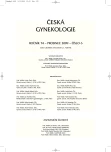Prenatal intracranial hemorrhagie – diagnosis and follow-up
Authors:
Z. Žižka 1; A. Malkovská 1; L. Hrazdírová 1; A. Pašková 1; D. Sebroň 1; Tomáš Fait 1
; L. Haaková 2; P. Calda 1
Authors‘ workplace:
Gynekologicko-porodnická klinika VFN a 1. LF UK, Praha, přednosta prof. MUDr. A. Martan, DrSc.
1; Ústav pro péči o matku a dítě, Praha, ředitel doc. MUDr. J. Feyereisl, CSc.
2
Published in:
Ceska Gynekol 2009; 74(6): 440-444
Overview
Aim:
We present a case of difficult prenatal diagnosis and follow-up of severe fetal intracranial hemorrhage. With an analysis of the available literature that is related to this topic, we would like to bring attention to the necessity of accurate evaluation of fetal brain morphology even during routine ultrasound examination in the late third trimester.
Type of study:
Case report.
Setting:
Department of Obstetrics and Gynecology, General Faculty Hospital and 1st Faculty of Medicine, Charles University, Prague.
Methods and results:
Four cases of prenatal intracranial hemorrhage are presented. All cases were diagnosed during ultrasound examination during the third trimester of pregnancy and the findings were clarified using nuclear magnetic resonance imaging. The etiology of the hemorrhage was determined in only two cases. Postnatal follow-up of the affected children over a range of one to two years of age shows a very severe prognosis of the described hemorrhagic conditions.
Conclusion:
Prenatally diagnosed fetal intracranial hemorrhage is a rare but severe complication in pregnancy associated with fetal and neonatal morbidity and mortality. A detailed description and precise image documentation of the damaged fetal structures have a fundamental forensic significance. Postnatal estimation of the time of hemorrhage using analysis of the cerebrospinal fluid and ultrasound findings (echogenicity of the lesions) is not always unified.
Key words:
fetal intracranial hemorrhage, ultrasound, prenatal diagnosis.
Sources
1. Carletti, A., Colleoni, GG., Perolo, A., et al. Prenatal diagnosis of cerebral lesions acquired in utero and with a late appearance. Prenat Diagn 2009, 29, 4, p. 389-395.
2. Cota, F., Zuppa, AA., Luciano, R., et al. A severe case of intracranial hemorrhage due to alloimmune thrombocytopenia. Matern Fetal Neonatal Med 2008, 21, 11, p. 852-854.
3. Elchalal, U., Yagel, S., Gomori, JM., et al. Fetal intracranial hemorrhagie (fetal stroke): does grade matter?: Ultrasound Obstet Gynecol, 2005, 26, p. 233-243.
4. Felderhoff-Muser, U., Bauer, M., Buhrer, C., et al. Ultrasound Obstet Gynecol 2001, 17, p. 248-251.
5. Gunn, TR., Becroft, DMO. Unexplained intracranial haemorrhage in utero: the battered fetus? Aust NZJ Obstet Gynaecol 1984, 24, p. 17-22.
6. Hedin, LW., Grimstad, H., Moller, A., et al. Prevalence of physical and sexual abuse before and during pregnancy among Swedish couple: Acta Obstet Gynaecol Scand 1999, 78, p. 310-315.
7. Huang Ying-Fen, Chen Wei-Chih, Tseng Jenn-Jhy, et al. Fetal intracranial hemorrhage (fetal stroke): report of four antenatally diagnosed cases and review of the literature: Taiwanese J Obstet Gynecol 2006, 45, 2.
8. Kawamura, Y., Kawamata, K, Shinya, M, et al. Vitamin K deficiency in hyperemesis gravidarum as a potential cause of fetal intracranial hemorrhage and hydrocephalus. Prenat Diagn 2008, 28, 1, p. 59-61.
9. Muench, MV., Zheng, M., Bilica, PM., et al. Prenatal diagnosis of a fetal epidural hematoma using 2- and 3-dimensional sonography and magnetic resonance imaging. J Ultrasound Med 2008, 27, 9, 1369-1373.
10. Póvoa, AM., Ramalho, C., Machado, AP., et al. Congenital posthemorrhagic hydrocephalus: a case of fetomaternal alloimmune thrombocytopenia. Fetal Diagn Ther 2007, 22, 5, p. 321-324.
11. Reiss, I., Gortner, L., Moller, J., et al. Fetal intracranial hemorrhage in the second trimester: diagnosis by sonography and magnetic resonance imaging. Ultrasound Obstet Gynecol 1996, 7, p. 49-51.
12. Sherer, DM., Anyaegbunan, A., Onyeije, C. Antepartum fetal intracranial hemorrhage, predisposing factors and prenatal sonography: a review: Am J Perinatol 1998, 15, p. 431-441.
13. Vergani, P., Strobelt, N., Locatelli, A., et al. Clinical significance of fetal intracranial hemorrhage: Am J Obstet Gynecol 1997, 175, p. 536-543.
Labels
Paediatric gynaecology Gynaecology and obstetrics Reproduction medicineArticle was published in
Czech Gynaecology

2009 Issue 6
Most read in this issue
- Prenatal intracranial hemorrhagie – diagnosis and follow-up
- Amniotic fluid interleukin 6 levels in preterm premature rupture of membranes
- Ovarian torsion in the first trimester gravidity after stimulation in vitro fertilization – case report
- Fertility preserving treatment of gynecological malignant tumors
